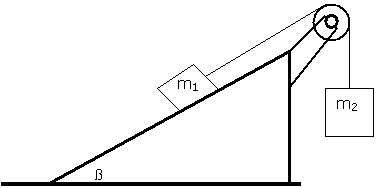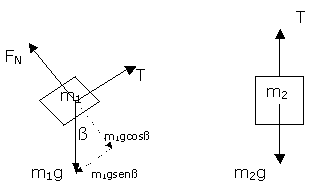Second Newton's Law Exercises
Inclined Plane, Detailed Example With and Without Friction
The pulley shown below is weightless and frictionless.
The block of mass m1 is on the plane, inclined at an angle ![]() with the horizontal. The block of mass m2 is connected to m1
by a string.
with the horizontal. The block of mass m2 is connected to m1
by a string.
a) Assuming there is no friction, show a formula
for the acceleration of the system in terms of m1, m2,
![]() and g.
and g.
b) What condition is required for m1 to go up the incline?
c) Assume that the coefficient of kinetic friction between m1 and
the plane is 0.2, m1 = 2 kg, m2 = 2.5 kg and the angle
![]() = 30║. Calculate
the acceleration of m1 and m2.
= 30║. Calculate
the acceleration of m1 and m2.
d) What is the maximum value of the friction coefficient so the system can
still move.

Before attempting to solve a Second Newton's Law problem like this it is very useful to take into account the following considerations:
Free Body Diagram.- In every problem where the Second Newton's Law applies it is fundamental to draw what is called the Free Body Diagram. This diagram must show all the external forces acting on a body. We isolate the body and the forces due to that strings and surfaces are replaced by arrows; of course, the friction forces and the force of gravity must be included. If there are several bodies, a separate diagram should be drawn for each one.
FREE BODY DIAGRAM

- The force that m1 exerts on m2 through the rope has the same magnitude T. This is so because a rope only changes the direction of a force, not its magnitude assuming a weightless rope.
- The magnitude of the acceleration is the same at both ends of the rope assuming an inextensible rope.
Components of Force.-
Notice from the diagram
the weight of m1 has been split into the components m1gsen![]() parallel to the incline, and m1gcos
parallel to the incline, and m1gcos![]() perpendicular to it.
perpendicular to it.
a) Let's assume the direction of the acceleration
makes m1 to go upward.
Sum of forces on m1 in the direction of the incline: T-m1gsen![]() =m1a
=m1a
Sum of vertical forces on m2 = m2g-T = m2a
And adding both equations we get m2g-m1gsen![]() = a(m1+m2)
= a(m1+m2)
Or a = g(m2-m1sen▀)/(m1+m2)
b) For a to be positive (i.e. m1
going up) m2 > m1sen![]()
For a to be negative(i.e. m1 going down) m2 < m1sen![]()
c) Now appears a friction force, always in
an opposite direction to the movement. The magnitude of this friction force
is Ff = ![]() FN.
FN is obtained using:
FN.
FN is obtained using:
Sum of forces perpendicular to the incline = FN-m1gcos![]() = 0
= 0
or FN = m1gcos![]() .
The friction force is then Ff =
.
The friction force is then Ff = ![]() m1gcos
m1gcos![]()
The sum of forces on m1 in the sense of the incline is now
(1) T-m1gsen![]() -
-![]() m1gcos
m1gcos![]() = m1a
= m1a
The sum of vertical forces on m2 is
(2) m2g-T = m2a
Adding (1) and (2) we get m2g-m1g(sen![]() +Ácos
+Ácos![]() )
= a(m1+m2)
)
= a(m1+m2)
Replacing values, with ![]() = 0.2, m1 = 2 kg, m2 = 2.5 kg and
= 0.2, m1 = 2 kg, m2 = 2.5 kg and ![]() = 30║ results a = 2.51 m/s2.
= 30║ results a = 2.51 m/s2.
d) As the coefficient of friction increases,
the acceleration decreases until reaching a value near zero or zero. This
condition is obtained with zeros in the right side of equations (1) and (2)
used before in answer c):
T-m1gsen![]() -
-![]() m1gcos
m1gcos![]() = 0
= 0
![]() m2g-T
= 0
m2g-T
= 0
And adding, we get m2g-m1gsen![]() -
-![]() m1gcos
m1gcos![]() = 0
= 0
Or ![]() = (m2-m1sen
= (m2-m1sen![]() )/m1cos
)/m1cos![]()
Replacing values we get ![]() = 0.87.
= 0.87.
Newton's Second Law Links:
Second Newton's Law, Theory and Examples
Second Newton's Law Examples, Part One
Related Sites:
· Physics, Main Page
· Physics, Mathematics
· Physics, Detailed Homework Scope Help
· Energy, Work and Power: Concepts
· Kinetic Energy
· Potential Energy
· Power
· Physics Problems, Example
· Physics Homework - Mechanical Energy Conservation Problems
· Physics Homework - Mechanical Power Problems
· Coulomb's Law
· Exercises Using Coulomb's Law
· Electric Field Charges
· Electric Field Exercises
· Electric Potential Energy
· Exercises, Electric Potential Energy
· Ohm's Law, Principle
· Ohm's Law Exercises
· Gauss' Law
· Sound Waves
· Sound Waves: Standing, Interference, Doppler Effect - Examples
· Sound Waves, Doppler Effect - Examples
· Vectors, Scalars
· Vectors, Scalars - Analytic Method
· Addition Vector Tools, Problems
· Free Fall Theory
· Free Fall Exercises, Part One
· Free Fall Exercises, Part Two
· Free Fall Exercises, Part Three